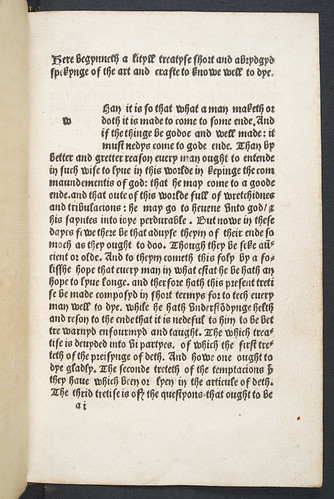The art and craft to know well to die.
Translated by William Caxton from L’art de bien vivre et de bien mourir (an abridged French version of De arte bene moriendi, or Ars moriendi).
[London]: Richard Pynson, [ca. 1495]
4to. a-b8 (first and third leaves of each gathering signed thus: ai, aii, bi, bii). [16] leaves.
Woodcut initials; woodcut printer’s device.
ISTC ia01140350; Duff 36; GW 2616.
| GIP number: | A104 |
| Shelf-mark: | Sp Coll Hunterian Bv.3.14 (see main library entry for this item) |
| Provenance: | John Ratcliffe (1707-1776), book collector: Ratcliffe’s inscription “Perfect” on front flyleaf; lot 738 in 'Bibliotheca Ratcliffiana' (1776). Gustavus Brander (1719/20-1787), merchant and antiquary: purchased by Brander for £0.16.0 at the Ratcliffe sale according to the annotated BL copy of the Ratcliffe sale catalogue (shelfmark 822.d.6). William Hunter (1718-1783), physician and anatomist: presumably acquired by Hunter directly from Brander (whose library was sold in 1790, seven years after Hunter’s death). University of Glasgow: Hunterian bequest 1807; Hunterian Museum bookplate on front pastedown, with former shelfmark “As.8.4”. |
| Binding: | England, 18th-century gold-tooled red goatskin; covers decorated with a floral and ornamental roll border; gold-tooled spine (fleur-de-lys ornament tooled upside down in each of the six compartments), without titling; gilt-edged leaves; crimson paste-paper endpapers. Size: 198 x 127 mm. |
| Leaf size: | 192 x 121 mm. |
| Annotations: | Letter “C” in brown ink on first front flyleaf. |
| Decoration: | None. |
| Imperfections: | None. |
| Digital version: | Available via Flickr. |





